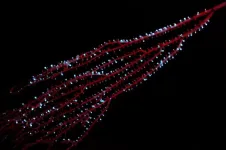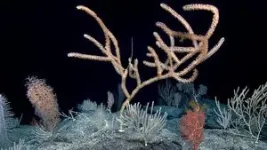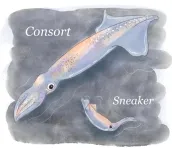(Press-News.org) Bioluminescence first evolved in animals at least 540 million years ago in a group of marine invertebrates called octocorals, according to the results of a new study from scientists with the Smithsonian’s National Museum of Natural History.
The results, published today, April 23, in the Proceedings of the Royal Society B, push back the previous record for the luminous trait’s oldest dated emergence in animals by nearly 300 million years, and could one day help scientists decode why the ability to produce light evolved in the first place.
Bioluminescence—the ability of living things to produce light via chemical reactions—has independently evolved at least 94 times in nature and is involved in a huge range of behaviors including camouflage, courtship, communication and hunting. Until now, the earliest dated origin of bioluminescence in animals was thought to be around 267 million years ago in small marine crustaceans called ostracods.
But for a trait that is literally illuminating, bioluminescence’s origins have remained shadowy.
“Nobody quite knows why it first evolved in animals,” said Andrea Quattrini, the museum’s curator of corals and senior author on the study.
But for Quattrini and lead author Danielle DeLeo, a museum research associate and former postdoctoral fellow, to eventually tackle the larger question of why bioluminescence evolved, they needed to know when the ability first appeared in animals.
In search of the trait’s earliest origins, the researchers decided to peer back into the evolutionary history of the octocorals, an evolutionarily ancient and frequently bioluminescent group of animals that includes soft corals, sea fans and sea pens. Like hard corals, octocorals are tiny colonial polyps that secrete a framework that becomes their refuge, but unlike their stony relatives, that structure is usually soft. Octocorals that glow typically only do so when bumped or otherwise disturbed, leaving the precise function of their ability to produce light a bit mysterious.
“We wanted to figure out the timing of the origin of bioluminescence, and octocorals are one of the oldest groups of animals on the planet known to bioluminesce,” DeLeo said. “So, the question was when did they develop this ability?”
Not coincidentally, Quattrini and Catherine McFadden with Harvey Mudd College had completed an extremely detailed, well-supported evolutionary tree of the octocorals in 2022. Quattrini and her collaborators created this map of evolutionary relationships, or phylogeny, using genetic data from 185 species of octocorals.
With this evolutionary tree grounded in genetic evidence, DeLeo and Quattrini then situated two octocoral fossils of known ages within the tree according to their physical features. The scientists were able to use the fossils’ ages and their respective positions in the octocoral evolutionary tree to date to figure out roughly when octocoral lineages split apart to become two or more branches. Next, the team mapped out the branches of the phylogeny that featured living bioluminescent species.
With the evolutionary tree dated and the branches that contained luminous species labeled, the team then used a series of statistical techniques to perform an analysis called ancestral state reconstruction.
“If we know these species of octocorals living today are bioluminescent, we can use statistics to infer whether their ancestors were highly probable to be bioluminescent or not,” Quattrini said. “The more living species with the shared trait, the higher the probability that as you move back in time that those ancestors likely had that trait as well.”
The researchers used numerous different statistical methods for their ancestral state reconstruction, but all arrived at the same result: Some 540 million years ago, the common ancestor of all octocorals were very likely bioluminescent. That is 273 million years earlier than the glowing ostracod crustaceans that previously held the title of earliest evolution of bioluminescence in animals.
DeLeo and Quattrini said that the octocorals’ thousands of living representatives and relatively high incidence of bioluminescence suggests the trait has played a role in the group’s evolutionary success. While this further begs the question of what exactly octocorals are using bioluminescence for, the researchers said the fact that it has been retained for so long highlights how important this form of communication has become for their fitness and survival.
Now that the researchers know the common ancestor of all octocorals likely already had the ability to produce its own light, they are interested in a more thorough accounting of which of the group’s more than 3,000 living species can still light up and which have lost the trait. This could help zero in on a set of ecological circumstances that correlate with the ability to bioluminesce and potentially illuminate its function.
To this end, DeLeo said she and some of her co-authors are working on creating a genetic test to determine if an octocoral species has functional copies of the genes underlying luciferase, an enzyme involved in bioluminescence. For species of unknown luminosity, such a test would enable researchers to get an answer one way or the other more rapidly and more easily.
Aside from shedding light on the origins of bioluminescence, this study also offers evolutionary context and insight that can inform monitoring and management of these corals today. Octocorals are threatened by climate change and resource-extraction activities, particularly fishing, oil and gas extraction and spills, and more recently by marine mineral mining.
This research supports the museum’s Ocean Science Center, which aims to advance and share knowledge of the ocean with the world. DeLeo and Quattrini said there is still much more to learn before scientists can understand why the ability to produce light first evolved, and though their results place its origins deep in evolutionary time, the possibility remains that future studies will discover that bioluminescence is even more ancient.
This study includes authors affiliated with Florida International University, the Monterey Bay Aquarium Research Institute, Nagoya University, Harvey Mudd College and University of California, Santa Cruz.
The research was supported by the Smithsonian, the David and Lucile Packard Foundation, Japan Science and Technology Agency and the U.S. National Science Foundation.
About the National Museum of Natural History
The National Museum of Natural History is connecting people everywhere with Earth’s unfolding story. It is one of the most visited natural history museums in the world. Opened in 1910, the museum is dedicated to maintaining and preserving the world’s most extensive collection of natural history specimens and human artifacts. The museum is open daily, except Dec. 25, from 10 a.m. to 5:30 p.m. Admission is free. For more information, visit the museum on its website, blog, Facebook, X (formerly Twitter) and Instagram.
# # #
END
Bioluminescence first evolved in animals at least 540 million years ago
Study focuses on an ancient group of marine invertebrates that includes soft corals, pushes back the previous oldest dated example of trait by nearly 300 million years
2024-04-24
ELSE PRESS RELEASES FROM THIS DATE:
Squids’ birthday influences mating
2024-04-24
The day a male spear squid hatches determines which mating tactic he will use throughout his life, according to new research. Spear squid (Heterololigo bleekeri) that hatch earlier in the season become “consorts” which fight for mating opportunities. Those which hatch later become “sneakers,” which use more clandestine mating tactics. Researchers found that the mating tactic determined by the birth date was fixed for the squid’s whole life. Understanding how mating tactics are influenced by birth date, and the environmental conditions at that time, can help researchers consider ...
Star bars show Universe’s early galaxies evolved much faster than previously thought
2024-04-24
Embargoed until 00:01am BST on Wednesday 24 April 2024/19.01pm ET on Tuesday 23 April 2024
-With pictures-
The Universe’s early galaxies were less chaotic and developed much faster than previously thought, according to new research looking back more than ten billion years in time.
An international team of astronomers led by Durham University, UK, used the James Webb Space Telescope (JWST) to find evidence of bar formation when the Universe was only a few billion years old.
Bars are elongated strips of stars found in disc or ...
Critical minerals recovery from electronic waste
2024-04-24
RICHLAND, Wash.—There’s some irony in the fact that devices that seem indispensable to modern life—mobile phones, personal computers, and anything battery-powered—depend entirely on minerals extracted from mining, one of the most ancient of human industries. Once their usefulness is spent, we typically return these objects to the Earth in landfills, by the millions.
But what if we could “mine” electronic waste (e-waste), recovering the useful minerals contained within them, instead of throwing them away? A clever method of recovering valuable minerals from e-waste, developed by a research team at the Department ...
The move by Apple Memories to block potentially upsetting content illustrates Big Tech’s reach and limits, writes Chrys Vilvang
2024-04-23
How do algorithms determine the way we interact with our memories?
It’s a uniquely 21st-century kind of question, and it is far from settled.
In a new paper in the journal Memory, Mind & Media, Concordia PhD candidate Chrys Vilvang argues that the way tech companies store, package and share personal content back to users is opaque. And, given one recent controversy, it’s open to important questions about selection and representation.
Vilvang’s paper looks at the discussion stemming from an April 2022 article on 9to5Mac, a tech news site dedicated to all things Apple. Its journalists were given access to the iOS 15.5 beta update, and they discovered ...
Chemical tool illuminates pathways used by dopamine, opioids and other neuronal signals
2024-04-23
Image
University of Michigan researchers have developed a new tool to better understand how chemicals like dopamine and epinephrine interact with neurons.
These chemicals are among a wide variety of signals that get processed in the brain through G protein-coupled receptors (GPCRs), proteins that sit on the surface of neurons to receive messages—in the forms of proteins, sugars, fats, even light—that inform cellular behavior.
GPCRs are involved in an enormous number of biological functions, making them a prime ...
Asian monsoon lofts ozone-depleting substances to stratosphere
2024-04-23
Asian monsoon lofts ozone-depleting substances to stratosphere
Airborne observations discover new link between pollution and climate
Powerful monsoon winds, strengthened by a warming climate, are lofting unexpectedly large quantities of ozone-depleting substances high into the atmosphere over East Asia, new research shows.
The study, led by the U.S. National Science Foundation National Center for Atmospheric Research (NSF NCAR) and NASA, found that the East Asian Monsoon delivers more than twice the concentration of very short-lived ozone-depleting substances into the upper troposphere and lower stratosphere than previously reported.
The research team ...
PET scans reveal ‘smoldering’ inflammation in patients with multiple sclerosis
2024-04-23
A Brigham and Women’s Hospital study of 30 people found that, in patients with MS, advanced brain imaging could identify hidden inflammation not picked up on traditional MRIs
The new technique could lead to more advanced treatments for multiple sclerosis
A new study from Brigham and Women’s Hospital, a founding member of the Mass General Brigham healthcare system, suggests positron emission tomography (PET) brain scans could reveal hidden inflammation in patients with multiple sclerosis (MS) who are being treated with highly-effective treatments. The findings were published ...
Genetics predict type 2 diabetes risk and disparities in childhood cancer survivors
2024-04-23
(MEMPHIS, Tenn. – April 23, 2024) Survivors of childhood cancer are at increased risk for cardiovascular disease, for which a risk factor is their greater prevalence of type 2 diabetes, with a disproportionate impact on those of non-European heritage. St. Jude Children’s Research Hospital scientists have identified four previously unknown genetic variants associated with diabetes risk in all survivors. Published today in the Journal of Clinical Oncology, their work also found an association between a previously ...
Health information on TikTok: The good, the bad and the ugly
2024-04-23
In today's digital age, social media platforms like TikTok have become integral parts of our lives, offering not just entertainment and catchy dances but also a wealth of information on topics ranging from home improvement to world news. According to some reports, many young people even prefer to use social media in place of traditional search engines like Google when looking for answers.
Health information is no exception. Hashtags like #celiactok, #diabetestok and #sinustok have millions of views, with each tag leading to countless videos about each health issue.
“Every type of ‘Tok’ exists – that’s just ...
New study points to racial and social barriers that block treatment for multiple myeloma
2024-04-23
A UC Davis Health study reveals persistent racial and social disparities preventing access to autoHCT, a common bone marrow transplant treatment to halt the progression of multiple myeloma.
An analysis of data from three California health care organizations, published in Clinical Lymphoma, Myeloma & Leukemia, showed that Black myeloma patients were less likely to receive autoHCT. This was despite having a greater risk of developing the cancer than other racial or ethnic groups. Patients using Medicaid, Medicare, or no insurance in California also accessed the treatment less than those with other insurance ...
LAST 30 PRESS RELEASES:
Why nail-biting, procrastination and other self-sabotaging behaviors are rooted in survival instincts
Regional variations in mechanical properties of porcine leptomeninges
Artificial empathy in therapy and healthcare: advancements in interpersonal interaction technologies
Why some brains switch gears more efficiently than others
UVA’s Jundong Li wins ICDM’S 2025 Tao Li Award for data mining, machine learning
UVA’s low-power, high-performance computer power player Mircea Stan earns National Academy of Inventors fellowship
Not playing by the rules: USU researcher explores filamentous algae dynamics in rivers
Do our body clocks influence our risk of dementia?
Anthropologists offer new evidence of bipedalism in long-debated fossil discovery
Safer receipt paper from wood
Dosage-sensitive genes suggest no whole-genome duplications in ancestral angiosperm
First ancient human herpesvirus genomes document their deep history with humans
Why Some Bacteria Survive Antibiotics and How to Stop Them - New study reveals that bacteria can survive antibiotic treatment through two fundamentally different “shutdown modes”
UCLA study links scar healing to dangerous placenta condition
CHANGE-seq-BE finds off-target changes in the genome from base editors
The Journal of Nuclear Medicine Ahead-of-Print Tip Sheet: January 2, 2026
Delayed or absent first dose of measles, mumps, and rubella vaccination
Trends in US preterm birth rates by household income and race and ethnicity
Study identifies potential biomarker linked to progression and brain inflammation in multiple sclerosis
Many mothers in Norway do not show up for postnatal check-ups
Researchers want to find out why quick clay is so unstable
Superradiant spins show teamwork at the quantum scale
Cleveland Clinic Research links tumor bacteria to immunotherapy resistance in head and neck cancer
First Editorial of 2026: Resisting AI slop
Joint ground- and space-based observations reveal Saturn-mass rogue planet
Inheritable genetic variant offers protection against blood cancer risk and progression
Pigs settled Pacific islands alongside early human voyagers
A Coral reef’s daily pulse reshapes microbes in surrounding waters
EAST Tokamak experiments exceed plasma density limit, offering new approach to fusion ignition
Groundbreaking discovery reveals Africa’s oldest cremation pyre and complex ritual practices
[Press-News.org] Bioluminescence first evolved in animals at least 540 million years agoStudy focuses on an ancient group of marine invertebrates that includes soft corals, pushes back the previous oldest dated example of trait by nearly 300 million years







